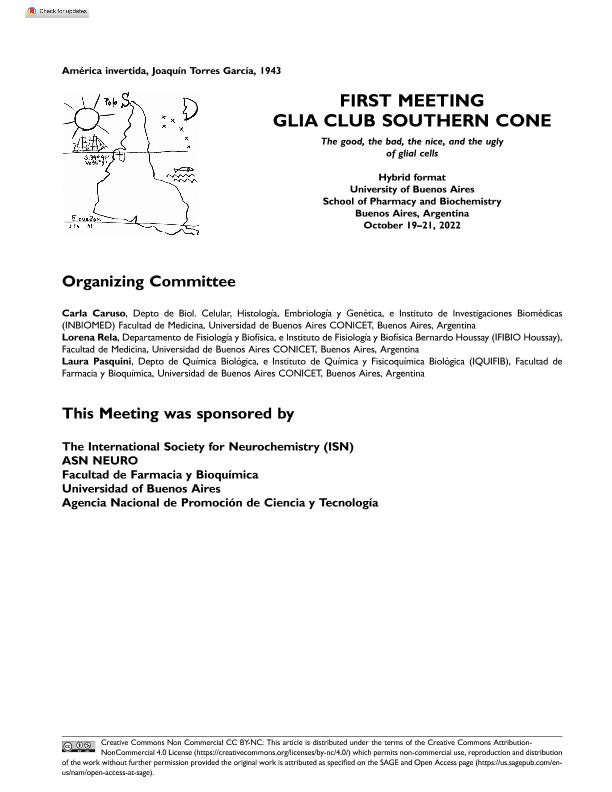Mostrar el registro sencillo del ítem
dc.contributor.author
Soto, Tamara Belen

dc.contributor.author
Politi, Luis Enrique

dc.contributor.author
German, Olga Lorena

dc.date.available
2023-07-28T14:52:00Z
dc.date.issued
2022
dc.identifier.citation
Damaging effects induced by BMAA on Muller glial cells; First meeting of the Glia Club Southern Cone; Argentina; 2022; 43-43
dc.identifier.issn
1759-0914
dc.identifier.uri
http://hdl.handle.net/11336/205986
dc.description.abstract
β-Methylamine-L-alanine (BMAA) is a non-proteinogenic aminoacidic cyanotoxin produced by several cyanobacteria. This cyanotoxin has been linked with the development of neurodegenerative diseases, like Amyotrophic Lateral Sclerosis, Alzheimer, and of some retinal pathologies. In the retina, it induces damaging effects on neurons and in Müller glial cells (MGCs), the major glial cell type, which have crucial roles in preserving normal retinal functionality. We have previously demonstrated that BMAA promotes neuronal degeneration with no protective effect observed by MGCs. In this work, we studied the direct effects of BMAA on MGCs in pure retinal glial cultures. For that purpose, we treated these cultures, obtained from newborn rat retinas, after cells were reseeded, with BMAA (0.4, 1, and 10 µM) at day 1 or at days 1 and 4. Cells were analyzed in either, in a short and in a long-term BMAA exposure of 3 and 9 days, respectively. We evaluated cell viability by DAPI staining and Trypan Blue assays; cellular metabolic activity by MTT assay, and cytoskeleton integrity by staining actin filaments with phalloidin. Our preliminary results showed that in both, short-term and long-term exposure of cultures to BMAA, MGCs displayed nuclear alterations without affecting the viability of these cells. Additionally, BMAA (1 and 10 µM) promoted an increase in the cellular metabolic activity in short-term, but not in long-term studies. Moreover, our results showed that BMAA induced actin network disorganization. Interestingly, in long-term exposure of cultures to BMAA, this toxin-induced an abnormal cytoplasmic growth. In conclusion, these results imply that BMAA induces several alterations in MGCs at the subcellular level without affecting their viability. Hence, these damages may help to understand neurodegenerative damages elicited by BMAA, which affect human health. Our knowledge of the molecular mechanisms involved in BMAA-induced cell damage could help to develop new therapeutic strategies
dc.format
application/pdf
dc.language.iso
eng
dc.publisher
SAGE Publications

dc.rights
info:eu-repo/semantics/openAccess
dc.rights.uri
https://creativecommons.org/licenses/by-nc-sa/2.5/ar/
dc.subject
BMAA
dc.subject
MULLER GLIAL CELLS
dc.subject
DEGENERATION
dc.subject
CELLULAR METABOLIC ACTIVITY
dc.subject.classification
Bioquímica y Biología Molecular

dc.subject.classification
Ciencias Biológicas

dc.subject.classification
CIENCIAS NATURALES Y EXACTAS

dc.title
Damaging effects induced by BMAA on Muller glial cells
dc.type
info:eu-repo/semantics/publishedVersion
dc.type
info:eu-repo/semantics/conferenceObject
dc.type
info:ar-repo/semantics/documento de conferencia
dc.date.updated
2023-06-15T18:01:59Z
dc.identifier.eissn
1759-0914
dc.journal.pagination
43-43
dc.journal.pais
Reino Unido

dc.journal.ciudad
Londres
dc.description.fil
Fil: Soto, Tamara Belen. Consejo Nacional de Investigaciones Científicas y Técnicas. Centro Científico Tecnológico Conicet - Bahía Blanca. Instituto de Investigaciones Bioquímicas de Bahía Blanca. Universidad Nacional del Sur. Instituto de Investigaciones Bioquímicas de Bahía Blanca; Argentina. Universidad Nacional del Sur. Departamento de Biología, Bioquímica y Farmacia; Argentina
dc.description.fil
Fil: Politi, Luis Enrique. Consejo Nacional de Investigaciones Científicas y Técnicas. Centro Científico Tecnológico Conicet - Bahía Blanca. Instituto de Investigaciones Bioquímicas de Bahía Blanca. Universidad Nacional del Sur. Instituto de Investigaciones Bioquímicas de Bahía Blanca; Argentina
dc.description.fil
Fil: German, Olga Lorena. Consejo Nacional de Investigaciones Científicas y Técnicas. Centro Científico Tecnológico Conicet - Bahía Blanca. Instituto de Investigaciones Bioquímicas de Bahía Blanca. Universidad Nacional del Sur. Instituto de Investigaciones Bioquímicas de Bahía Blanca; Argentina. Universidad Nacional del Sur. Departamento de Biología, Bioquímica y Farmacia; Argentina
dc.relation.isreferencedin
info:eu-repo/semantics/reference/url/https://ri.conicet.gov.ar/handle/11336/120553
dc.relation.alternativeid
info:eu-repo/semantics/altIdentifier/url/https://journals.sagepub.com/doi/10.1177/17590914221138206
dc.relation.alternativeid
info:eu-repo/semantics/altIdentifier/doi/http://dx.doi.org/https://doi.org/10.1177/17590914221138206
dc.conicet.rol
Autor

dc.conicet.rol
Autor

dc.conicet.rol
Autor

dc.coverage
Internacional
dc.type.subtype
Reunión
dc.description.nombreEvento
First meeting of the Glia Club Southern Cone
dc.date.evento
2022-10-19
dc.description.paisEvento
Argentina

dc.type.publicacion
Journal
dc.description.institucionOrganizadora
Universidad de Buenos Aires. Facultad de Farmacia y Bioquímica
dc.description.institucionOrganizadora
Club de la Glia
dc.source.revista
ASN Neuro
dc.date.eventoHasta
2022-10-21
dc.type
Reunión
Archivos asociados
